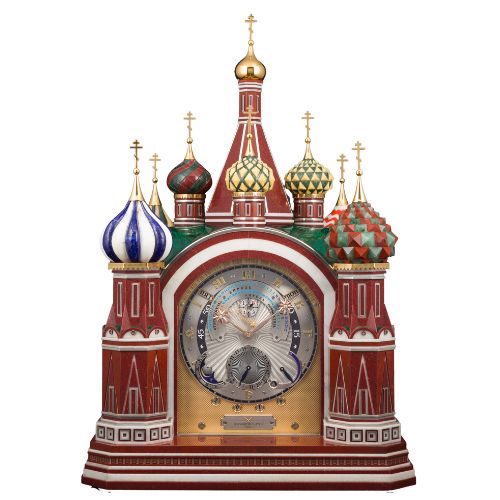The Moscow Computus Clock
With spring and Easter just around the corner, let’s look at the complicated field of computus clocks, and focus on one master horologist. The Moscow Computus Clock, or Moskovskaya Paskhaliya as it is also known, is the pinnacle of Russian horology. It was conceived and built by Konstantin Chaykin, the only Russian member of the Académie Horlogère des Créateurs Indépendants. Boasting twenty-seven individual complications, it is the most complex clock ever created in Russia.
Computus clocks and watches are specifically designed timepieces used to calculate and display the date of Easter. For those who aren’t aware, Easter (also called Pascha in many parts of the world) is a Christian festival celebrating the resurrection of Jesus Christ three days after his crucifixion and death. It is what’s known as a “moveable feast”, a celebration that takes place at different times in different years.
In A.D. 350, Roman emperor Constantine the Great convened the First Council of Nicaea to discuss a mandate on uniform observance of the date of Easter. During the council, Christian leaders set two rules regarding Easter: one, the month would be reckoned separately from the Jewish calendar and always fall after the equinox; and two, all Christians would celebrate the feast on the same day. There was no mention by this time that Easter should fall on a Sunday, and the actual rules for computation were figured out as they were needed. Today, Easter is celebrated on the first full moon on or after the spring equinox and cannot fall on the same day as the 15th of Nisan in the Jewish calendar. Determining the date of Easter requires tracking several variables: the motion of the sun, the phases of the moon, the days of the week, and differences between calendars. Special mathematical functions were developed to determine when the feast would happen each year. After the Gregorian reform of 1582, the date of Easter in Western Christendom began to differ from Eastern Christendom, which uses the Julian calendar to this day.
While the leaders of both the East and the West have recently tried to find a way to celebrate Easter on a common date, their differences seem to make it a dream rather than an impending reality. For one Russian watchmaker, however, this simply meant he needed to build a clock that could track both dates simultaneously.
In 2010, Konstantin Chaykin became the first – and to date only – Russian member of the Académie Horlogère des Créateurs Indépendants (AHCI), serving as President from 2016 through 2019. Chaykin has been creating watches and clocks for over twenty years, and in his career, he has constructed multiple computus clocks, each more beautiful and complicated than the last.
Born in the Soviet Union in 1975, he states his childhood was like that of most Soviet boys, however, he began to explore radio engineering and began eventually practicing building radios, as well. He followed this passion first through school and later in his military service, where for seven months he was the only signalman in his unit. After returning from service, he worked multiple jobs: a mechanic, a sales agent, and the director of a woodworking company. In 2000, Chaykin started his own watch business – he was engrossed by watchmaking. By 2003, he created a golden watch, as a gift, for his father’s 50th birthday, which inspired him to want to make a tourbillon watch. In 2005, he completed his second table tourbillon clock and his first Easter computus, the Easter of Christ Computus Clock. Three more computus clocks followed, with the most recent being the Moscow Computus. By 2021, he had attained eighty-nine patents for his work.
Externally, the Moscow Computus is based on the stunning architecture of Moscow, with a fair amount of personal flourish, and stands 17.32 inches tall. Chaykin intentionally crafted this clock to venerate the ancient, white-walled capital of Russia, but chose St. Basil’s Cathedral instead of the red-bricked facade of the Kremlin. Internally, the TC0.03-1 movement comprises of 2,506 individual parts — including 13 jewels and 102 ball bearings — plus twenty-seven complications spread across four dials. These include the computus, perpetual calendar, 10-day power reserve indicator, a planisphere with Moscow’s sky map, a season indicator, and the day length in Moscow, to name only a few.

Of the complications featured in the clock, the one that perhaps stands out the most is the Analemma module. The modern word “analemma” is defined as a figure-eight curve that results when the Sun’s position in the sky is plotted out over the year at the same hour of mean solar time every day. The term comes from an instrument which, by making the lengths of the shadows of a fixed gnomon (a carpenter’s square, used as the pointer of the sundial), showed the different altitudes of the sun at the different periods of the year. In the master’s own words: “I had been considering the analemma module for nine years. The analemma itself resembles the symbol of infinity, and whatever I did, my thoughts constantly returned to the idea of realizing in the clock this most interesting astronomical phenomenon. For nine years I came up with different variations of such a module, and the last one, installed in the Moscow Computus Clock, is the finest in its construction.” There is no other clock in the world, yet, to feature an Analemma complication, making the Moscow Computus utterly unique. The movement was made entirely at the Konstantin Chaykin manufactory using classical techniques, including fine longitudinal and circular grinding, manual chamfering and polishing, spherical polishing of the axle tips, and electroplating with nickel and gold.
With construction complete, what he did he do after he finished the Moscow Computus? Well, he immediately started on his next work of art, The Lucomorye – of course.

